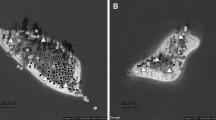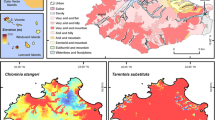Abstract
We examined how a weed affected the basking and activity of a diurnal lizard, and the potential cascading effects of these shifts for life history strategies and expression of morphology. Hatchlings of the diurnal lizard Lampropholis delicata were raised to maturity in outdoor enclosures that mimicked high, moderate and low invasion by a sprawling plant (blue periwinkle, Vinca major). Skinks depend on sunlight for growth and maintenance. Periwinkle differs from displaced grassland by being structurally complex and blocking sunlight. Lizards restricted to the enclosure floor achieved preferred body temperatures only when exposure to periwinkle was moderate or low. However, lizards in high invasion enclosures could reach preferred body temperatures by climbing plants and basking on exposed canopy. This shift in basking strategy resulted in lizards growing longer hind limbs compared with animals that rarely (moderate invasion) and never (low invasion) climbed plants. Consequently, lizards reared in high invasion enclosures sprinted faster than conspecifics reared in lower invasion environments. Throughout the study there was no significant variation among treatments in the tendency of animals to be moving when they were not hidden. However, lizards in high invasion treatments hid more often during the day, were lighter in body mass, and females had lighter clutch masses and offspring than did those from moderate and low invasion enclosures. Thus, microhabitat degradation can drive a cascade of changes to an animal’s ecology.



Similar content being viewed by others
References
Aebischer N, Robertson P, Kenward R (1993) Compositional analysis of habitat use from animal radio-tracking data. Ecology 74:1313–1325
Autumn K, De Nardo D (1995) Behavioural thermoregulation increases growth-rate in a nocturnal lizard. J Herpetol 29:157–162
Ayers D, Shine R (1997) Thermal influences on foraging ability: body size, posture and cooling rate of an ambush predator, the python Morelia spilota. Funct Ecol 11:342–347
Bauwens D, Garland T Jr, Castilla A, Van Damme R (1995) Evolution of sprint speed in lacertid lizards: morphological, physiological, and behavioural covariation. Evolution 49:848–863
Bennett A (1983) Ecological consequences of activity metabolism. In: Huey RB, Pianka ER, Schoener TW (eds) Lizard ecology: studies of a model organism. Harvard University Press, Cambridge, MA, pp 11–23
Bennett A, Nagy K (1977) Energy expenditure in free-ranging lizards. Ecology 58:697–700
Bilcke J, Downes S, Buscher I (2006) Combined effect of incubation and ambient temperature on the feeding performance of a small ectotherm. Aust Ecol 31(8):937–947
Casey T, Joos B, Fitzgerald T, Yurlina M, Young P (1988) Synchronized group foraging, thermoregulation, and growth of Eastern tent caterpillars in relation to microclimate. Physiol Zool 61:372–377
Christian K, Bedford G (1995) Seasonal changes in thermoregulation by the frillneck lizard, Chlamydosaurus kingii, in tropical Australia. Ecology 76:124–132
Dawson R, Lawrie C, O’Brien E (2005) The importance of microclimate variation in determining size, growth and survival of avian offspring: experimental evidence from a cavity nesting passerine. Oecologia 144:449–507
Doughty P, Reznick D (2004) Patterns and analysis of adaptive phenotypic plasticity in animals. In: De Witt T, Scheiner S (eds) Phenotypic plasticity: functional and conceptual approaches. Oxford University Press, Oxford, pp 126–150
Downes S (2001) Trading heat and food for safety: costs of predator avoidance in a lizard. Ecology 82:2870–2881
Downes S, Bauwens D (2004) The outcome of first encounters affects ensuing social relations within dyads of lacertid lizards. Behav Ecol 15:938–945
Downes S, Shine R (2001) Why does tail loss increase a lizard’s later vulnerability to snakes? Ecology 82:1293–1303
Gerald G, Spezzano L (2005) The influence of chemical cues and conspecific density on the temperature selection of a freshwater snail (Melanoides tuberculata). J Therm Biol 30:237–245
Heinrich B (1993) The hot-blooded insects: strategies and mechanisms of thermoregulation. Harvard University Press, Cambridge, MA
Hertz P, Huey R (1981) Compensation for altitudinal changes in the thermal environment by some Anolis lizards on Hispaniola. Ecology 62:515–521
Hoefer A, Goodman B, Downes S (2003) Two inexpensive and effective methods for restraining living lizards. Herpetol Rev 34:223–224
Huey R, Kingsolver J (1989) Evolution of thermal sensitivity of ectotherm performance. Trends Ecol Evol 4:131–135
Huey R, Webster T (1976) Thermal biology of Anolis lizards in a complex fauna: the cristatellus group on Puerto Rico. Ecology 57:985–994
Irschick D, Losos J (1999) Do lizards avoid habitats in which performance is submaximal? The relationship between sprinting capabilities and structural habitat use in Caribbean anoles. Am Nat 154:293–305
Joos B, Casey T, Fitzgerald T, Buttemer W (1988) Roles of the tent in behavioural thermoregulation of eastern tent caterpillars. Ecology 69:2004–2011
Karlsson B, Wiklund C (2005) Butterfly life history and temperature adaptations: dry open habitats select for increased fecundity and longevity. J Anim Ecol 74:99–104
Licht P, Dawson W, Shoemaker V, Main A (1966) Observations on the thermal relations of western Australian lizards. Copeia 1966:97–111
Losos J, Creer D, Glossip D, Goellner R, Hampton A, Roberts G, Haskell N, Taylor P, Ettling J (2000) Evolutionary implications of phenotypic plasticity in the hind limb of the lizard Anolis sagrei. Evolution 54:301–305
Merckx T, Van Dyck H (2006) Landscape structure and phenotypic plasticity in flight morphology in the butterfly Pararge aegeria. Oikos 113:226–232
Nice C, Fordyce J (2006) How caterpillars avoid overheating: behavioural and phenotypic plasticity of pipevine swallowtail larvae. Oecologia 146:541–548
Pough F (1980) The advantages of ectothermy for tetrapods. Am Nat 115:92–112
Pough F, Gans C (1982) The vocabulary of reptilian thermoregulation. In: Gans C, Pough F (eds) Biology of the Reptilia (Physiological Ecology, vol 12). Academic, New York, pp 17–23
Prosser C (2004) Effects of habitat modification associated with urbanisation on the garden skink, Lampropholis guichenoti. B.Sc. Honours thesis, University of Sydney, Sydney
Qualls F, Shine R (1998) Geographic variation in lizard phenotypes: importance of the incubation environment. Biol J Linn Soc 64:477–491
Schäuble C, Grigg G (1998) Thermal ecology of the Australian agamid Pogona barbata. Oecologia 114:461–470
Schwarzkopf L, Shine R (1992) Costs of reproduction in lizards: escape tactics and susceptibility. Behav Ecol Sociobiol 31:17–25
Shine R, Wall M, Langkilde T, Mason R (2005) Scaling the heights: thermally driven arboreality in garter snakes. J Therm Biol 30:179–185
Sinervo B, Adolph S (1989) Thermal sensitivity of growth rate in hatchling Sceloporus lizards: environmental, behavioural and genetic aspects. Oecologia 78:411–419
Sinervo B, Licht P (1991) Hormonal and physiological control of clutch size, egg size, and egg shape in side-blotched lizards (Uta stansburiana): constraints on the evolution of lizard life histories. J Exp Zool 257:256–264
Stamp N (1980) Egg deposition patterns in butterflies: why do some species cluster their eggs rather than deposit them singly? Am Nat 115:367–380
Torr G, Shine R (1996) Patterns of dominance in the small scincid lizard Lampropholis guichenoti. J Herpetol 30:230–237
Twyford K, Baxter G (1999) Chemical control of blue periwinkle (Vinca major L.) in Croajingolong National Park, Victoria. Plant Prot Q 14:47–50
Van Damme R, Bauwens D, Castilla A, Verheyen R (1990) Comparative thermal ecology of the sympatric lizards Podarcis tiliguerta and Podarcis sicula. Acta Oecologia 11:503–512
Van Damme R, Wilson R, Van Hooydonck B, Aerts P (2003) Performance constraints in decathletes. Nature 415:755–756
Vitt L, Avila-Pires T, Zani P, Esposito M (2002) Life in shade: the ecology of Anolis trachyderma (Squamata: Polychrotidae) in Amazonian Ecuador and Brazil, with comparisons to ecologically similar anoles. Copeia 2002:275–286
Yelenik S, Stock W, Richardson D (2004) Ecosystem level impacts of invasive Acacia saligna in the South African fynbos. Restor Ecol 12:44–51
Acknowledgements
We thank the Keogh lab for support and advice. We are grateful to M. Halloy for helping to the collect data for the laboratory study on activity. G. Blouin-Demers and three anonymous reviewers provided critical reviews that significantly improved this paper. The Australian Research Council (Large Grant to S.D.) funded this project. Lizards were collected with permission of the New South Wales National Parks and Wildlife Service (permit #A2976), and experiments were approved by the Australian National University Animal Experimentation and Ethics Committee (protocol #F.BTZ.33.01) and comply with the current animal experimentation laws of Australia.
Author information
Authors and Affiliations
Corresponding author
Additional information
Communicated by Sven Bacher.
Rights and permissions
About this article
Cite this article
Downes, S., Hoefer, AM. An experimental study of the effects of weed invasion on lizard phenotypes. Oecologia 153, 775–785 (2007). https://doi.org/10.1007/s00442-007-0775-2
Received:
Accepted:
Published:
Issue Date:
DOI: https://doi.org/10.1007/s00442-007-0775-2




